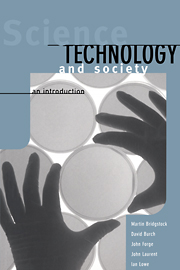Book contents
- Frontmatter
- Contents
- List of Figures
- List of Tables
- List of Contributors
- Preface
- Part One Scientific and Technological Communities
- Part Two Scientists and Technologists in the Wider Society
- 6 The Industrial Revolution in Great Britain
- 7 Science, Technology and the Economy
- 8 Science, Technology and Economic Theory
- 9 Science, Technology and Public Policy
- 10 Science, Technology and the Less-developed Countries
- 11 Science, Technology and the Future
- Appendix 1 Surviving in the Information Jungle
- Appendix 2 Referencing
- Index
7 - Science, Technology and the Economy
Published online by Cambridge University Press: 04 February 2010
- Frontmatter
- Contents
- List of Figures
- List of Tables
- List of Contributors
- Preface
- Part One Scientific and Technological Communities
- Part Two Scientists and Technologists in the Wider Society
- 6 The Industrial Revolution in Great Britain
- 7 Science, Technology and the Economy
- 8 Science, Technology and Economic Theory
- 9 Science, Technology and Public Policy
- 10 Science, Technology and the Less-developed Countries
- 11 Science, Technology and the Future
- Appendix 1 Surviving in the Information Jungle
- Appendix 2 Referencing
- Index
Summary
In this book so far, readers have been introduced to a range of issues involved in the interactions of science, technology and society, and it has been seen that science and technology have been steadily growing in importance throughout history, especially since the so-called Scientific Revolution of the sixteenth century, at about the time of Copernicus. Much of this importance has arisen from the employment of science and technology, from an early date in the economic sphere—as was seen, for example, in Newton's attempted experiments in alchemy (Westfall 1994) and, more recently and seriously, the vast expenditure on R&D in the drugs industry. But contrary to a commonly held view—that there exists some kind of inevitability in scientific and technological ‘progress’—it can be shown that conscious decision by policy-makers can have a major bearing on the directions taken by science and technology, including the kinds of economic activity in which science and technology are employed. In this chapter, specific illustrations of this general principle will be given, beginning with a study of the British alkali industry of the eighteenth and nineteenth centuries, and following this with a comparison of the ways in which science and technology have been utilised in Australia and in two highly industrialised nations—Sweden and Japan.
The British alkali industry
In Chapter 6, it was explained that the Industrial Revolution of the late eighteenth and early nineteenth centuries in England and Continental Europe, at first based on textile manufacturing, largely took place without science.
- Type
- Chapter
- Information
- Science, Technology and SocietyAn Introduction, pp. 132 - 158Publisher: Cambridge University PressPrint publication year: 1998



